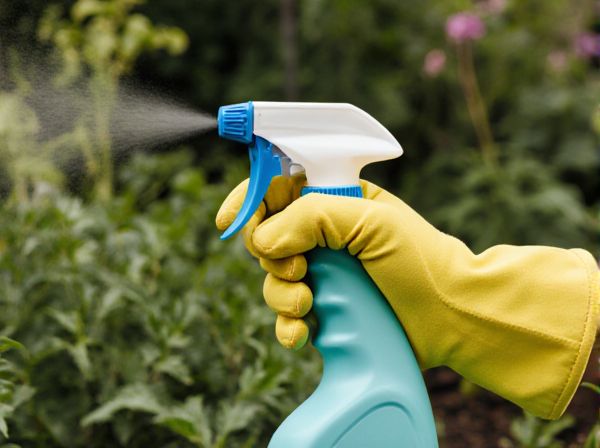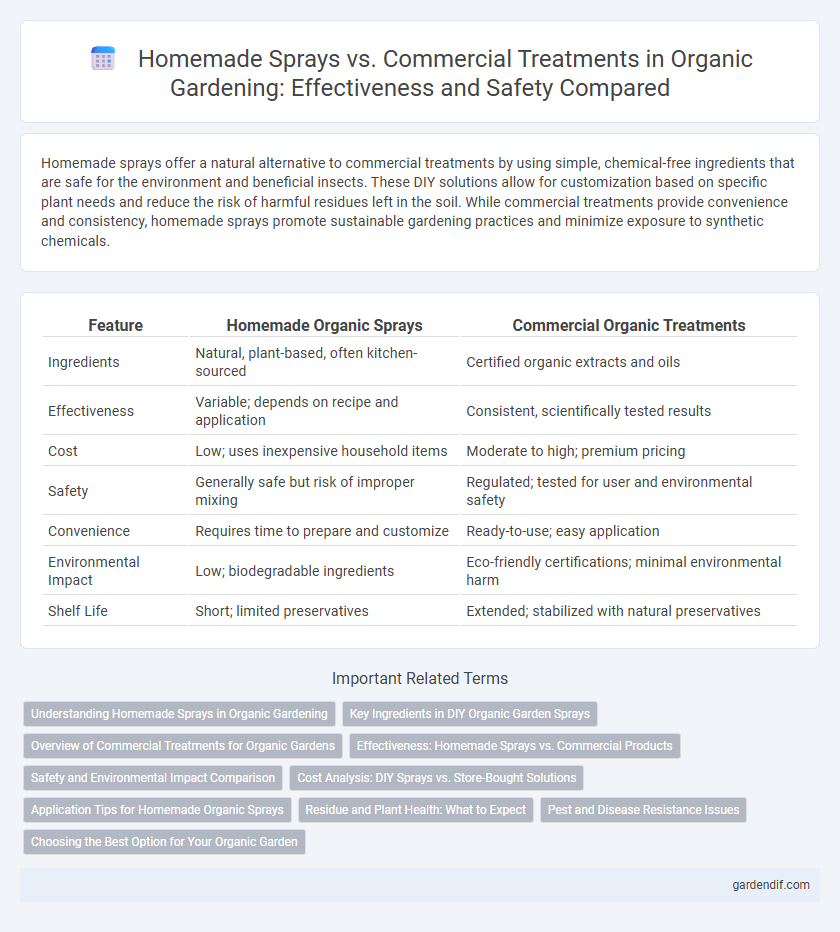
Homemade sprays vs commercial treatments Illustration
Homemade sprays offer a natural alternative to commercial treatments by using simple, chemical-free ingredients that are safe for the environment and beneficial insects. These DIY solutions allow for customization based on specific plant needs and reduce the risk of harmful residues left in the soil. While commercial treatments provide convenience and consistency, homemade sprays promote sustainable gardening practices and minimize exposure to synthetic chemicals.
Table of Comparison
| Feature | Homemade Organic Sprays | Commercial Organic Treatments |
|---|---|---|
| Ingredients | Natural, plant-based, often kitchen-sourced | Certified organic extracts and oils |
| Effectiveness | Variable; depends on recipe and application | Consistent, scientifically tested results |
| Cost | Low; uses inexpensive household items | Moderate to high; premium pricing |
| Safety | Generally safe but risk of improper mixing | Regulated; tested for user and environmental safety |
| Convenience | Requires time to prepare and customize | Ready-to-use; easy application |
| Environmental Impact | Low; biodegradable ingredients | Eco-friendly certifications; minimal environmental harm |
| Shelf Life | Short; limited preservatives | Extended; stabilized with natural preservatives |
Understanding Homemade Sprays in Organic Gardening
Homemade sprays in organic gardening utilize natural ingredients like neem oil, garlic, and soap to control pests and diseases without harmful chemicals. These sprays are cost-effective, biodegradable, and customizable to specific garden needs, promoting a healthier ecosystem. Unlike commercial treatments, homemade options minimize environmental impact and support sustainable gardening practices.
Key Ingredients in DIY Organic Garden Sprays
Key ingredients in DIY organic garden sprays typically include neem oil, garlic extract, and insecticidal soap, known for their natural pest-repellent properties. Homemade sprays often contain essential oils like peppermint or rosemary, which provide antimicrobial and antifungal benefits without harmful chemicals. These plant-based components offer an eco-friendly alternative to commercial treatments, promoting sustainable garden health and minimizing chemical residue.
Overview of Commercial Treatments for Organic Gardens
Commercial treatments for organic gardens often include certified organic pesticides, fungicides, and insecticides that comply with USDA Organic standards. These products typically contain natural active ingredients such as neem oil, potassium bicarbonate, or pyrethrin, designed to protect plants from pests and diseases without synthetic chemicals. Their formulation ensures consistent efficacy, ease of application, and long shelf life compared to homemade sprays.
Effectiveness: Homemade Sprays vs. Commercial Products
Homemade sprays often use natural ingredients like vinegar, essential oils, and baking soda, providing targeted pest control and reducing chemical exposure, though their effectiveness can vary based on formulation and application frequency. Commercial treatments typically offer more consistent and scientifically tested results due to standardized ingredients and concentrations specifically designed to eliminate pests or diseases efficiently. Consumers seeking organic solutions should weigh the cost-effectiveness and potential environmental impact of homemade remedies against the reliability and faster action of commercial products.
Safety and Environmental Impact Comparison
Homemade sprays made from natural ingredients like vinegar, baking soda, and essential oils offer safer alternatives to commercial treatments, reducing exposure to harmful chemicals for both users and pets. Commercial treatments often contain synthetic pesticides and preservatives that may contribute to environmental pollution, bioaccumulation, and toxicity in non-target species. Choosing homemade sprays minimizes chemical runoff, lowers ecological risks, and supports sustainable pest management practices.
Cost Analysis: DIY Sprays vs. Store-Bought Solutions
DIY homemade sprays typically cost significantly less per application compared to commercial treatments, as ingredients like vinegar, baking soda, and essential oils are affordable and often available in bulk. Commercial solutions, while convenient and formulated for specific pests, incur higher expenses due to branding, packaging, and chemical additives, which can increase annual pest control budgets by 20-40%. Analyzing cost-effectiveness reveals that homemade sprays offer a budget-friendly alternative without compromising organic principles, particularly for small-scale or routine use.
Application Tips for Homemade Organic Sprays
For effective application of homemade organic sprays, use a fine mist sprayer to ensure even coverage on plant leaves and stems, targeting both the upper and lower surfaces to maximize pest control. Apply sprays during early morning or late afternoon to avoid leaf burn and enhance absorption without disrupting beneficial insects. Frequent reapplications, every 7-10 days or after heavy rain, maintain protection and effectiveness against pests and diseases.
Residue and Plant Health: What to Expect
Homemade sprays typically leave minimal residue compared to commercial treatments, which often contain synthetic chemicals that can accumulate on plant surfaces. This reduced residue from homemade remedies supports better plant health by minimizing potential phytotoxicity and preventing soil contamination. Expect gentler, more biodegradable options with homemade sprays that maintain plant vitality without harmful chemical buildup.
Pest and Disease Resistance Issues
Homemade sprays often rely on natural ingredients like neem oil, garlic, or soap solutions, offering limited but targeted pest and disease resistance with reduced chemical impact. Commercial treatments typically provide broader-spectrum protection and longer-lasting effects due to synthetic active ingredients, but may lead to resistance development and environmental concerns. Balancing the efficacy of homemade remedies with the reliability of commercial products is crucial for sustainable pest management in organic gardening.
Choosing the Best Option for Your Organic Garden
Homemade sprays for organic gardens often use natural ingredients like neem oil, garlic, and vinegar, providing a chemical-free alternative that supports soil health and beneficial insects. Commercial organic treatments, certified by organizations such as OMRI, offer convenience and proven efficacy but may contain processed inputs. Selecting the best option depends on factors like pest severity, garden size, and personal commitment to sustainability and ingredient transparency.
Homemade sprays vs commercial treatments Infographic

 gardendif.com
gardendif.com